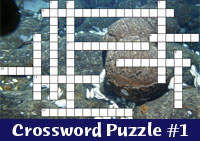|
|
Organized Chaos at the Alvin Basket Each evening when Alvin returns to the ship, a half dozen biologists wearing rubber gloves and lugging plastic buckets of chilled seawater swarm the sub for what Adam Soule calls “the frenzy.” Jockeying for space, scientists circle Alvin’s loaded basket to retrieve as many as three dozen types of vent animals for dissection, chemical preservation, and freezing on the ship. Scientists on our expedition are studying the genetics and ecology of animals at Rosebud, and much of that research will continue weeks from now when we return to shore. Proper care of the samples now, when they are fresh, will provide for the most accurate scientific results. The scene at Alvin may look like a cattle stampede, but it’s closer to a choreographed ballet. Two hours before Alvin ascends to the surface, one of the scientists in Alvin calls the ship to report the number of tubeworms, crabs, snails and other animals they are bringing to the surface, as well as their positions in various plastic boxes and containers secured in the sub’s basket. This saves time for microbiologists Naomi Ward and Kevin Penn, who study the relationship between bacteria and tubeworms, clams, and other vent organisms. They need to take animals from the basket fast to avoid contamination. “We don’t want any human bacteria to get on our samples, so we have to work quickly and make sure everything is kept clean,” said Naomi. She and Kevin have established a sort of triage system for retrieving their samples, loading them on to white trays then whisking them to the cold room to scrape off bacteria. While sorting and organizing the animals, all are kept on ice or in cold seawater. “If you leave fresh animals out they will rot, like food does. Then they are not useful to our research,” said Breea Govenar. Dissection begins after dinner in a music-filled lab strung with twinkling chili pepper lights, creating a festive atmosphere for work that won’t end until 3 a.m. Biologists divide chores and work systematically: Rhian Waller, Kevin Penn, and Kate Buckman remove shells, muscles, and gills from mussels. Walter Cho stores each part in small labeled plastic bags. Breea uses a microscope to identify different worms. Abby Knee sieves water left over in collection boxes, plucking out worms, limpets, and shrimp. Close to midnight, the nostril-twisting smell of sulfur brought back from the vents in the animals’ tissue fills the room. The odor doesn’t ruin the biologists’ appetites. “I’m always famished after this for my favorite late night snack,” said Breea. “Peanut butter and Oreo cookies.” Mail Buoy Do you have questions about oceanographic research, hydrothermal vents, or about what it is like to work on board a ship? E-mail your questions to the scientists working on board RV Atlantis at divediscover@atlantis.whoi.edu. Please tell us your town and state, and keep your messages short with no attachments. Read today's mail »
|
|||||||||||||||||||||||||||||||||||||||||||||||||||||||||||||||||||||||||||||||||||||||||||||
Mailing List | Feedback | Glossary | For Teachers | About Us | Contact
© 2010 Dive and Discover™. Dive and Discover™ is a registered trademark of
Woods
Hole Oceanographic Institution




